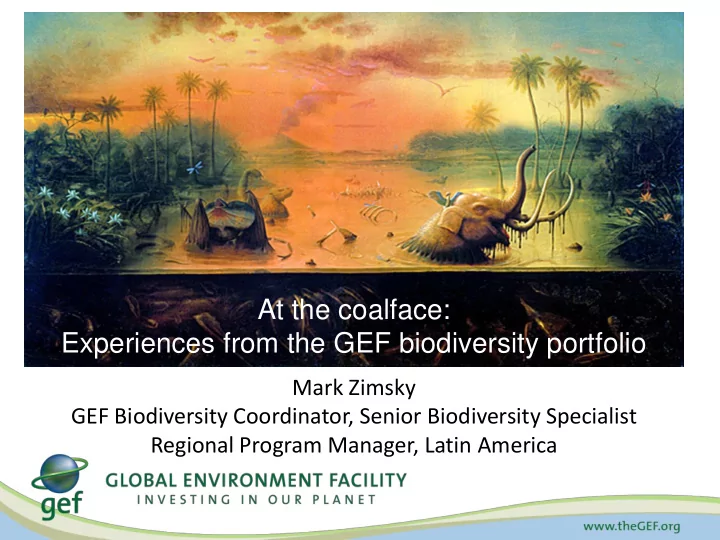

At the coalface: Experiences from the GEF biodiversity portfolio Mark Zimsky GEF Biodiversity Coordinator, Senior Biodiversity Specialist Regional Program Manager, Latin America
Back to the future: mainstreaming has deep roots in the GEF
GEF funding of mainstreaming Policy and regulatory frameworks: subsidies and incentives Spatial and land-use planning Improving and changing production practices: agriculture, forestry, fisheries, tourism, extractive industries (oil, gas, and mining) Financial mechanisms
GEF mainstreaming by the numbers: what countries prioritized from 2004-2014
GEF mainstreaming by the numbers: $ invested • GEF3 (2002-2006): ~65% (protected areas), ~35% (mainstreaming) • GEF 5 (2010-2014): ~55% (protected areas), ~45% (mainstreaming) • 2004-2014: 327 mainstreaming projects totaling $1.6 billion leveraging $5.2 billion in cofinancing
Mainstreaming Defined: 2005 To internalize the goals of biodiversity conservation and the sustainable use of biological resources into economic sectors and development models, policies and programmes, and therefore into all human behaviour.
Mainstreaming in Practice: 2014 Biodiversity mainstreaming is the process of embedding conservation considerations into policies, strategies, and practices of key public and private actors that impact or rely on biodiversity, so that biodiversity is conserved and sustainably used both locally and globally.
Mainstreaming (in conservation/development): A key concept known only to us (and a handful of our friends)
Many believe intuitively that mainstreaming has worked • But we are not well positioned to quantify our impacts . . . • . . . or assessing effectiveness of specific mainstreaming approaches
Negative externalities of top 3,000 companies estimated at US$2.15 trillion per annum……
Moderators of project/program which consistently contribute to success • Pre-requisite factors that are not part of the design and that are largely unaffected by the investment, but influence the magnitude and quality of the outcome: – Democratic, transparent and stable governance systems – Strong and detailed science-based biophysical and socio-economic data and knowledge at appropriate scales (to inform trade-off discussions as there are trade offs) – Strong capacity at individual and institutional levels
Features of the project/program that facilitate success • Design elements, which can be changed by project/program designers or implementers, that make the project more successful; (basically variants of the project dimensions) – Project design and operational strategy embedded within a theory of change for biodiversity mainstreaming that clearly links interventions to desired outcomes within overarching hypotheses which allows for adaptive management and developing evidence on what works and what doesn’t – Effective monitoring and evaluation systems: notoriously weak for most mainstreaming interventions
Features of the project/program that facilitate success – Flexible project duration (persistence and longevity) because mainstreaming is a complex, at times costly process requiring long-term investment strategies and implementation plans
Making the “case” to actors outside the biodiversity sector; e.g. South Africa Biodiversity messaging must first answer a rational need , then satisfy an emotional need. The champions of biodiversity need to demonstrate practical applications that warrant the allocation of scarce government resources. National Children’s Practical Asset Legacy Solutions
Amidst uncertainty going forward in GEF 6: Exploiting Opportunities for Biodiversity Mainstreaming at Scale through Integrated Responses – Integrated approach programs (IAPs) in GEF-6: (i) Sustainable Cities; (ii) Taking Deforestation out of Commodity Supply Chains; (iii)) Fostering Sustainability and Resilience for Food Security in Sub-Saharan Africa – An increasing portfolio of multi-focal area projects and programs: Amazon Sustainable Landscapes Program
Program 10 in GEF-6 Biodiversity Strategy: Integration of BD and ES into Development and Finance Planning
Thank you for your attention.
Recommend
More recommend